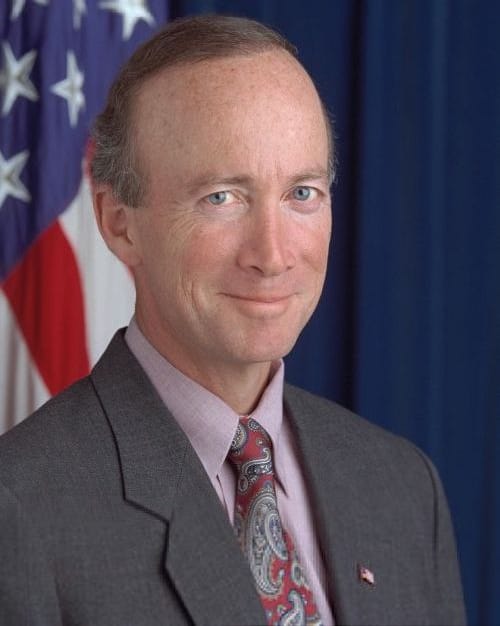At first blush, it would appear that Indiana Governor Mitch Daniels and former Secretary of Education Margaret Spellings have a lot in common. Both served as cabinet members in the George W. Bush Administration. Both are generally pragmatic centrists. And both hold strong school-reform instincts.
But look closer and the similarities—on federal education policy at least—disappear.

Photo in the public domain
In his big speech last week at the American Enterprise Institute, Governor Daniels went out of his way to stress that school reform—at the state and federal levels—is a work in progress. “The real test for us is dead ahead, and that is to implement these tools,” he said. “I will never stop learning about learning.”
Furthermore, while applauding President Obama and Secretary Duncan for their excellent work on education in general, and Race to the Top in particular, he indicated that a smaller federal footprint is appropriate. Of the federal education bureaucracy, he said, “There’s a lot more of it than we need.” The governor is humble about his accomplishments in Indiana and humble about what the feds can do to fix our schools. “I don’t have magic answers,” he said. “If I did I would have been here giving this talk years ago.”
Secretary Spellings, however, will have none of it. In a new ESEA reauthorization proposal she penned for the U.S. Chamber of Commerce last week, she encourages Congress to double-down on No Child Left Behind and set its sights even higher on what Uncle Sam can do to improve the nation’s schools.
The Chamber’s proposal starts by maintaining almost every detail of NCLB as we know it: State standards and cut scores benchmarked against NAEP; a “date certain” for getting “all students to proficiency in reading and math”; annual measurable objectives with “ambitious” timelines; consequences for (all) schools and districts not meeting their goals. And on and on it goes, traipsing through the greatest hits of NCLB ideas that have been tried and failed.

Photo in the public domain
Give Spellings some credit for consistency. This is, almost verbatim, the same proposal she made a few years ago as Secretary. And yet, she writes, her blueprint builds “on what we’ve learned.” How so? What exactly has she learned? Clearly not that the feds have proven wholly incapable of implementing such key NCLB components as public-school choice and interventions in failing schools. Nor has she recognized that, while Uncle Sam can force states and districts to do things they don’t want to do, he can’t force them to do those things well. And she seems completely blind to all the research showing that prescribing timelines and objectives and mandatory consequences gave states a big fat incentive to maintain a low bar on the standards themselves—and that “benchmarking” against NAEP proved useless to thwarting this trend. If she’s “learned” so much, why hasn’t her position budged an inch since 2001?
Granted, I may be caught up in the Mitch Daniels fervor. If he were to run, to make it past the primaries, and to get elected president (three HUGE ifs), who knows what his actual federal education policy would be. Maybe he’d end up more like Ms. Hubris than Mr. Humble. But for now I’ll just celebrate the fact that a key Republican governor is willing to admit: None of us knows for sure what to do, so let’s give it our best shot and remain willing to change our minds along the way.
| Click to listen to commentary on the Chamber's ESEA proposal from the Education Gadfly Show podcast |
This piece originally appeared (in a slightly different form) on Fordham’s blog, Flypaper. To get timely updates from Fordham, subscribe to Flypaper.
